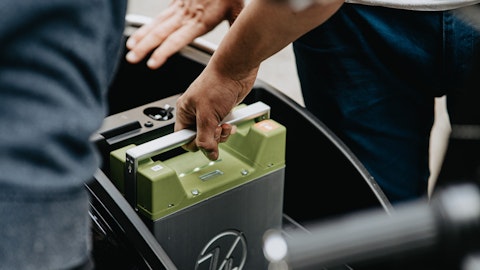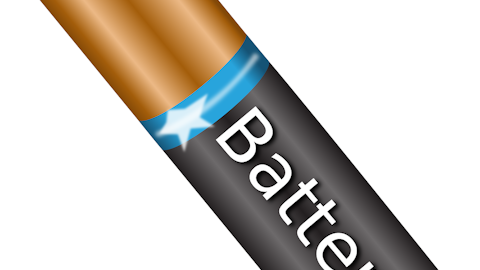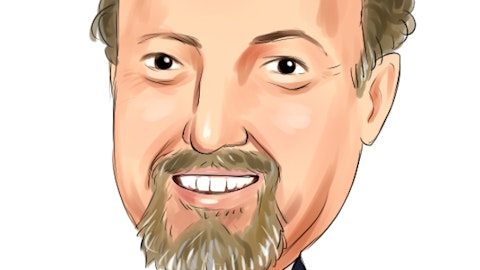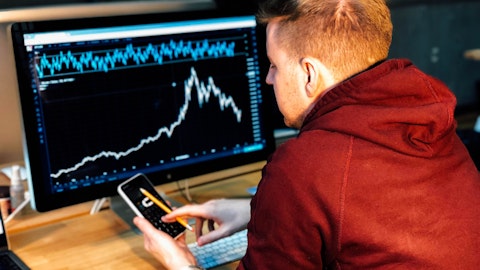QuantumScape Corporation (NYSE:QS) Q3 2023 Earnings Call Transcript October 25, 2023
Operator: Good day and welcome to QuantumScape’s Third Quarter 2023 Earnings Conference Call. John Saager, QuantumScape’s Vice President of Capital Markets and FP&A, you may now begin your conference.
John Saager: Thank you, operator. Good afternoon and thank you to everyone for joining QuantumScape’s third quarter 2023 earnings call. To supplement today’s discussion, please go to our IR website at ir.quantumscape.com to view our shareholder letter. Before we begin, I want to call your attention to the safe harbor provision for forward-looking statements that is posted on our website as part of our quarterly update. Forward-looking statements generally relate to future events, future technology progress, or future financial or operating performance. Our expectations and beliefs regarding these matters may not materialize. Actual results and financial periods are subject to risks and uncertainties that could cause actual results to differ materially from those projected.
There are risk factors that may cause actual results to differ materially from the content of our forward-looking statements for the reasons that we cite in our shareholder letter, Form 10-K and other SEC filings, including uncertainties posed by the difficulty in predicting future outcomes. Joining us today will be QuantumScape’s Co-founder, CEO and Chairman, Jagdeep Singh; our CFO, Kevin Hettrich; and a new addition to our team, Dr. Siva Sivaram, President. With that, I’d like to turn the call over to Jagdeep.

A fleet of eco-friendly electric cars, a symbol of the company’s commitment to sustainability. Editorial photo for a financial news article. 8k. –ar 16:9
Jagdeep Singh: Thanks, John. I’d like to begin today’s call by introducing our newly hired President Dr. Siva Sivaram. Siva holds a PhD in material science and brings extensive experience in high-volume manufacturing of advanced technology products, most recently serving as President at Western Digital, a global leader in solid-state and magnetic data storage. Before that, he held leadership positions at pioneering technology companies, including SanDisk, Matrix Semiconductor, and Intel. We’re thrilled to have him on board. I’ll start by covering our customer prototype testing. As we reported last year, we shipped our first A0 prototype cells to prospective customers in Q4 2022, with the goal of providing a proof-of-concept demonstration of a 24-layer anode-free solid-state lithium-metal battery cell.
We can now share that our top performing A0 prototype cell in our automotive OEMs battery testing labs achieved over 1,000 full cycle equivalents with over 95% discharge energy retention using customer-specified test conditions of C/3 charge and C/2 discharge with our standard temperature and pressure conditions and 100% depth of discharge. I’d like to point out that this is the best performing cell, and we have work to do on aspects such as reliability. Nonetheless, this is an exceptional result. We’re not aware of any automotive-format lithium-metal battery that has shown such high discharge energy retention over a comparable cycle count at room temperature and modest pressure, regardless of C-rate. We believe that no competing electrolyte, solid or liquid has demonstrated sufficient stability with lithium-metal to achieve this, and that this result sets a new high-water mark for lithium-metal battery performance.
This result is especially meaningful because the A0 prototype has the same number of layers as our production-intent cell and uses our proprietary cell format. Together with the higher-loading cathode results reported in our Q1 2023 shareholder letter, we have now separately demonstrated three key aspects of our production-intent cell design: 24 layers, higher cathode loading, and our new cell format. When these aspects are combined, along with improvements to packaging efficiency and manufacturing process controls and automation for improved reliability, it forms the core of our first commercial product, QSE-5. The cover photo of this quarter’s shareholder letter shows a mockup of our QSE-5 cell format. It’s important to keep in mind that since QSE-5 will have higher-loading cathodes and more efficient packaging than our A0 prototype cell, it will sustain higher current densities and be built with tighter margins, resulting in more stress on the cell.
We must also continue to work on producing these cells in large volumes with high quality and reliability. These factors present significant challenges. Nevertheless, we believe this remarkable result makes clear that our technology can achieve disruptive performance at commercial-intent layer counts, further increasing our confidence in the transformative potential of our technology and product roadmap. Next, a word about our customer engagements. Right now, our primary focus is on QSE-5 development, with the goal of enabling superior performance on a range of potential automotive applications across motorsport, passenger and commercial vehicles, including motorcycles, cars, trucks, and SUVs. As we reported last quarter, we’re collaborating closely with a prospective launch customer in the automotive sector for QSE-5.
While the scale of this initial application is by design small, it represents an important vehicle proof-of-concept that we believe has high visibility and the potential to lead to other programs in the future. We’re pleased with the progress the joint teams have made so far on module and pack integration and system design, the significant work remains. For example, we continue to refine and finalize the design parameters of QSE-5, which will determine the specific thermal and mechanical behavior of the cell. Beyond automotive, we remain engaged with prospective customers in the consumer electronics sector. And in Q3, we entered into a technology evaluation agreement with a leading global consumer electronics player. We believe the ability of our solid-state platform to maintain good cycling performance with zero externally applied pressure meets a key design requirement for these applications.
The single-layer sister cells that we first reported on in our Q3 2022 shareholder letter have now achieved between 1,500 and 2,000 cycles to approximately 80% discharge energy retention with zero externally applied pressure. Next, an update on our product development. Our planned first commercial product is QSE-5, which uses the proprietary format first demonstrated in A0 prototypes last year. This innovative format is a hybrid of conventional pouch and prismatic cell designs to address the uniaxial expansion of lithium metal as it plates and strips during charging and discharging. We call this novel format FlexFrame. A key technical goal for the year is to improve cell packaging efficiency relative to the A0 prototype cells we shipped to prospective customers in 2022.
This involves reducing the space taken up by the inactive material and FlexFrame package, as well as increasing the amount of active material in the cell, which we expect will enable the final commercial design to reach our energy density targets. When comparing the A0 prototype to our current B0 design, the B0’s are designed to pack the same number of layers with more energy per layer into a slimmer cell package. We plan to provide a detailed look at the innovative FlexFrame architecture in an upcoming webinar. Now, let me hand it over to Siva for an update on our manufacturing scale-up.
Siva Sivaram: Thanks, Jagdeep. I’ll begin with an update on our Raptor process. As a remainder, Raptor is designed to deliver up to three times as much throughput using similar equipment to our last-generation process, while applying less energy per separator. In Q3, we began process qualification of the Raptor equipment on schedule. Process qualification involves producing films, gathering data to characterize their quality and consistency, and using that feedback to refine out process specs. We are pleased with the early returns from the qualification testing. And while there is work remaining to dial in this process, we continue to target deployment of Raptor by the end of the year. We also continue to make progress on our next-generation Cobra process, which is planned to support higher-volume B-sample production from our consolidated QS-0 pre-pilot line.
Along with separator heat treatment equipment, in Q3 we took delivery, installed, and commissioned key pieces of equipment related to process automation, such as unit-cell assembly equipment. More automation not only increases our cell production capacity, but also reduces manual handling, which is a common source of run-to-run variation and tends to adversely impact reliability. We plan to continue process development and automation deployment to enable higher quality, consistency, and throughput as we build out our manufacturing capability. Overall, we are pleased with our manufacturing scale-up progress, but more work remains, including continuing to drive our defect reduction and quality improvement initiatives, integrating advanced metrology and data collection, and developing additional process automation.
With that, let me turn things over to Kevin for an update on our financial outlook.
Kevin Hettrich: Thanks, Siva. Third quarter 2023 capital expenditures were $18 million. GAAP operating expenses were $121 million. Cash operating expenses, defined as operating expenses less stock-based compensation and depreciation were $64 million. For the full year 2023, we maintain our guidance on cash operating expenses of $225 million to $275 million, and revise our CapEx guidance to $75 million to $100 million. Approximately one-third of the reduction in expected CapEx spend is due to realized savings. Examples include successful value engineering, negotiated price reductions, and completion of certain projects under budget. The remaining approximately two-thirds is due to shifts in timing, which can be broken down into three broad categories.
Certain items we deferred because we had additional schedule buffer, items where we previously forecasted more front-loaded, payment timings and what will actually be required, and updates to aspects of our equipment strategy. Despite these changes in the timing of CapEx, we continue to target low-volume B samples in 2024 and higher-volume B samples in 2025. During Q3, our CapEx primarily went toward facility and equipment spend for our consolidated QS-0 pre-pilot line, including for our Raptor process. For the remainder of the year, our CapEx will continue to be predominantly allocated toward QS-0. During the quarter, we raised $300 million in gross proceeds from our public follow-on offering. We ended Q3 with over $1.1 billion in liquidity and continue to look for opportunities to optimize our spending and be prudent with our strong balance sheet.
We now forecast our cash runway will extend into 2026. Any additional funds raised from capital markets activity, including under our ATM prospectus supplement, would further extend this cash runway. Longer term, our capital requirements will be a function of our industrialization business model, which we believe could reflect a mix of wholly owned production, joint venture, and licensing relationships. With that, I’ll hand things over to Jagdeep for a final word on our strategic outlook.
Jagdeep Singh: Thanks, Kevin. Fundamentally, our focus for 2023 is simple, turn the corner from prototype to product. Our key milestones are all aimed at advancing product development to build a sufficient level of technical and manufacturing maturity to enable initial production of the QSE-5 cell. With just a few months remaining in the year, we’re maintaining aggressive near-term schedules and remain focused on bringing a potentially disruptive first product to market in the near future. But strategically, our mission is bigger than a series of near-term objectives. We’ve been pursuing a next-generation electric vehicle battery for over a decade. And with a mission as challenging and as important as this, long-term thinking is indispensable.
Moreover, the market opportunity for our technology platform is massive, potentially in the hundreds of billions of dollars annually for decades to come. With that in mind, this year we’ve also taken steps to strengthen our long-term strategic position. For example, this quarter we seized the opportunity to fortify our balance sheet, extending our forecasted cash runway into 2026 and securing funding for pivotal development and deployment milestones, including higher-volume B samples based on our Cobra separator process, which, if achieved, would have a transformative effect on our business. We’ve also built on our strong customer relationships and deepened our engagement with a prospective launch customer for our first product. And we continue to add manufacturing experience and technical excellence to our teams at every level.
At the close of Q3, we feel prepared to face the inevitable and innumerable short-term challenges on the way to our goal, because we’ve laid a strong foundation for long-term success. We look forward to reporting on the challenges and the successes in the quarters to come.
A – John Saager: Thanks, Jagdeep. We’ll begin today’s Q&A portion with a few questions we’ve received from investors, or that I believe investors would be interested in. Jagdeep, we’ll start with you. And I wanted to ask about our newly hired President, Dr. Siva Sivaram. Could you tell me a little bit about your expectations for him in his new role, and why you felt somebody with his background and experience was a good fit for us at this stage of our development?
Jagdeep Singh: Sure. So we’re thrilled to have Siva join the team. We’ve said our — that our main goal for the year was to turn the corner from prototype to product. In support of that, we’ve be working on the scale-up of the manufacturing processes, equipment and automation associated with higher-volume, higher-quality production. A key part of this is, of course, having the expertise needed to do this. We wanted to bolster our senior management team with someone who brought not only super high-volume production experience, but experience in sophisticated manufacturing processes such as those found in the semiconductor or magnetic storage industries. But we don’t think we could have found a better fit than with Siva, who was President at Western Digital, then one of the world’s largest data storage companies with $18 billion in revenue in 2022 and something like a 40% share of the hard drive market.
The company shipped literally millions of units per year, and these units involved highly advanced manufacturing processes and supply chains. For example, as you might know, modern disc drives had magnetic heads that float on the order of 5-nanometers above the surface of a platter, spinning at several thousand RPM, and do this repeatedly and with very high reliability. He was also a pioneer in multilayer semiconductor technology, which now routinely achieves over 200 layers. We think all of his experience will be invaluable as we scale up our equipment and increase our quality and reliability.
John Saager: Okay, and now a question for Siva. Siva, now that you’ve been with QuantumScape for a couple of months, I wanted to get your initial impressions as well as your assessment. Why do you think QuantumScape’s technology is scalable and what needs to be done to make that happen?
Siva Sivaram: Thanks, John. It’s been a very active and involved last couple of months. Even before I came to the company, I spent a lot of time developing an understanding of the electrochemistry, the material science, the thermodynamics of QuantumScape’s technology. But now that I’m here, what has interested me, first and foremost, is the quality and commitment of the people, the depth of expertise and experience that’s here within QuantumScape. I see the rigor that we have in development and the collection and management of data that gives me confidence in the company’s core competencies. It’s very interesting to note the similarities to my prior semiconductor and magnetic storage experience, whether it is on hardware assembly, semiconductor backend, or battery manufacturer as we scale to higher volumes, the key to scaling is defect reduction, process control and a high level of automation.
I’ve also seen that the ecosystem at QuantumScape is very well developed to provide the incoming material, equipment, setting up a very robust supply chain. And the depth of interaction with top-tier customer, their sturdy feedback, this sets the tone for continuous improvement as we ramp. Overall, the company and the technology are well poised for scaling.
John Saager: Great. Thanks so much, Siva. Kevin, turning to you, a question submitted by one of our investors. Can you provide some additional context on the $300 million follow-on offering closed in August? How does this fit into your long-term approach to capital management?
Kevin Hettrich: Thank you, John, for the question on behalf of the investor. In the first half of this year, we hit several product and manufacturing milestones on the path to commercialization. We believe that the time was right for a follow-on equity offering based on product manufacturing and customer momentum of the company. On the product development front, recall that in our Q2 shareholder letter, we shared higher cathode performance — the higher cathode-loading performance data and shipped unit cells with these cathodes to multiple partners. On the manufacturing front, in Q2, we completed site acceptance for our Raptor equipment, tracking to our year-end goal to deploy the fast separator process. And on the customer front, we had announced that we engaged with a prospective launch customer in the automotive space to bring QSE-5 to market.
So, we felt like we were on strong footing on a number of fronts and wanted to ensure that our capital — the capital runway would extend into 2026, which funds the build-out of our QS-0 Cobra line and production of our higher-volume B samples targeted at the end of 2025.
John Saager: Okay, great. Thanks, Kevin, so much for the insight. Jagdeep, with approximately two months left in the year, can you summarize for investors how we’re tracking against our 2023 goals that we laid out for investors in February? Specifically, what work remains to be done?
Jagdeep Singh: Sure, John. So at the beginning of the year, we laid out four key goals for the year that we thought were critical to helping turn the corner from prototype to production. The first was to increase the loading of the cathode from approximately 3 milliamp-hours per centimeter squared to approximately 5 milliamp-hours per centimeter squared to store more energy in the cell. We reported on the Q2 call that we achieved this higher-loading cathode and in fact, shipped unit-cell prototypes with these new cathode to customers. The second key goal was to improve the efficiency of packaging. And on this front, our new FlexFrame package incorporates a number of improvements from narrower edge margins, the thinner [contractors] (ph) and thinner adhesive layers. The other two goals were production related and having to do with our Raptor process and reliability. And I’ll turn it over to Siva to talk about those.
Siva Sivaram: Thanks, Jagdeep. The third goal was to install and deploy our new Raptor process. We’ve installed and qualified the Raptor equipment, we’re starting to produce high-quality films and are optimizing the process to meet our performance targets. We’re making good progress towards Raptor deployment by the end of the year. And finally, on reliability. We have undertaken and completed over a dozen initiatives to reduce defectivity and are now focused on process enhancements that we believe will take our reliability up to a new level. Of course, reliability is never done. It requires an ongoing effort to weed out and eliminate potential failure modes, especially as we introduce newly improved scaled-up processes.
John Saager: Okay. Thanks so much, guys. We’re now ready to begin the live portion of today’s call. Operator, please open up the line for questions.
See also Top 10 Oil and Gas Stocks To Buy and 12 Best Telecom Stocks To Buy Right Now.
Q&A Session
Follow Quantumscape Corp
Follow Quantumscape Corp
Operator: Thank you. [Operator Instructions]. Your first question comes from the line of Douglas Dutton with Evercore ISI. Your line is open.
Douglas Dutton: Hi, Jagdeep and Kevin. And welcome, Siva. Appreciate the nice update here. Can I just quickly ask for a little more detail on the B-sample timeline, specifically if you can confirm when the timeline for production with Raptor looks to be right now? Previously, I believe you said about 18 months after the A-sample, which would imply the B-sample timing around mid-2024. This release only quotes calendar year 2024. So is there anything else you can tell us on the timing for those first B0 samples, given that it seems the Raptor certification and testing process is coming along well?
Jagdeep Singh: Yes, we’re — as Siva mentioned, we’re pleased with the way the Raptor qualification process is going. The equipment is being installed and we’re qualifying the process as we speak for deployment later this year. And we do believe we’re still targeting 2024 for the low-volume B samples. When we provided the 18-month guidance, that of course was a general, approximate guidance, but I think the targets that we’re still tracking to are in 2024 is when we hope to have — when we are targeting to have the first low-volume B0 samples. Subsequently to that, we expect to have higher-volume B samples using the new Cobra process before the end of 2025. So, those are the two key milestones for us coming up next year and the year after, using the Raptor process to introduce low-volume B samples in 2024. And the Cobra process, which is even faster, as you know, to introduce the higher-volume B samples in 2025.
Douglas Dutton: Okay, that’s helpful. And then just a quick one on Toyota’s solid-state news over the last couple days. The company has claimed a doubling of EV range with their solution. There’s no “new tech here”, right? They’re simply adding in significantly more kilowatt-hours toward the smaller space required in a solid-state design to achieve that stated range. Is that your understanding? Thanks, team.
Jagdeep Singh: Yes. So, first of all, I want to say that we’re genuinely pleased to see a company like Toyota endorsing solid-state batteries as the future of EVs. We obviously agree. We’ve been on solid-state for a long time. Having said that, Toyota has announced that it’s using a sulfide-based approach, which does come with some challenges. We’ve done a lot of work on sulfides ourselves here. We got our patent portfolio, a number of the patents are in the sulfide space. And one of the key challenges with sulfide-based approaches is low cycle life that results from poor electrochemical stability and the propensity to form lithium-metal dendrites. Now if the dendrite problem isn’t addressed, then there are sort of two basic options.
One is to revert back to a carbon or silicon-based host material as opposed to lithium-metal, but then that results in reduced energy density and power density relative to a lithium-metal anode. And the other option is to run under what we consider to be compromised test conditions, i.e., elevated temperatures or very high pressures, or low rates of charge and discharge, or a short cycle life. So, all of those approaches, we think, make the approach unsuitable for commercial vehicles. We’re not aware of data from anyone that demonstrated these fundamental challenges of lithium-metal dendrite formation in sulfide-based systems has been addressed at room temperature and modest pressures. But if data exists, we welcome seeing it. And of course, the data we shared today, if you look at the first chart in our shareholder letter, that shows data from our A0 24-layer prototype cells, which of course we shipped in 2022, that achieves 1,000 cycles with a remarkable 95% capacity retention.
Which as we mentioned in the call, we believe is a highwater mark for cycle life in an automotive-format solid-state lithium-metal battery. So, we think the data is pretty clear on the capabilities of this approach.
Operator: Your next question comes from the line of Winnie Dong with Deutsche Bank. Your line is open.
Winnie Dong: Hi, thanks so much for answering the questions. I was wondering if you can elaborate on the challenges being written about in the shareholder letter, more specifically on combining the high cathode-loading with more efficient packaging, and then in the new QSE-5 format. Especially, like what are the hurdles that need to be overcome for this combination to be successful?
Jagdeep Singh: Yeah. It’s a good question. So, as we pointed out in the letter, if you look at the differences between the A0 we shipped last year and the QSE-5 that we intend to ship next year, there was a few key areas where — that account for the biggest differences. One is the layer count — I’m sorry, the layer count is, in fact, the same. We’re shipping — the QSE-5 will be a 24-layer cell, and the A0’s that we shipped last year were also 24-layer cells. So, we’ve shown we can do that. The second thing that the QSE-5 needs to have is a higher-loading cathode. So, specifically, a roughly 5 milliamp hour per centimeter squared loading cathode. The A0’s we shipped had 3 milliamp hour but — and we showed, earlier this year, results from 5 milliamp hour cathodes.
I think it was on the Q2 call. And we’ve since shipped those cells with those higher-loading cathodes to customers. The third piece is, we need to put all this into our new, more efficient FlexFrame package. And we’ve mentioned on the call that we’ve already made progress towards that in the form of reduced margins and thinner adhesive layers and [indiscernible] layers. All those we think will play into that. So, when you take those three things that we’ve demonstrated separately and combine them together and then add to that the improvements that we’re talking about with reliability that come from process control and more automation, you end up with the core of what is QSE-5. The way we’re thinking about it is from a risk standpoint, we believe we’ve demonstrated many of the key aspects of the QSE-5 cell already separately, and sort of if you use software terminology, at the unit-cell level — unit test level.
And now we just need to bring them together into an integrated cell. So it’s more of an integration task between now when we have QSE-5 than it is a task of developing fundamentally new features. So that’s kind of where we are on QSE-5.
Winnie Dong: Thank you. That’s really helpful. And then on the work with the prospective launch customer for QSE-5, is there any additional color you can provide in terms of initial customer feedback or testing feedback thus far? Example, are the design parameters that this customer is looking at in line with, less or more stringent than the gold standards that you’re targeting in terms of cell performance?
Jagdeep Singh: Yes, that’s a great question. So, one of the criteria we had to pick this initial launch customer was we wanted a customer that was excited about the QSE-5 cell as is. Because obviously, we don’t want to have to go redesign the cell or change the form factor or do anything else that could delay our time to market. So we’re pleased that this particular customer is in fact excited about the capabilities of QSE-5. And I think we reported on the QSE-5 capabilities in our last earnings call, where we showed a landscape map of energy versus power, and we believe that QSE-5 occupies a unique space in that landscape. The other thing about this customer is that the volume needs that they have, we believe we can satisfy from our QS-0 facility here in San Jose.



